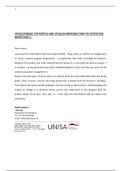1
STA1510 (BASIC STATISTICS) AND STA1610 (INTRODUCTION TO STATISTICS)
NOTES PART 1
Dear student,
I pray that this information finds you in good health. These notes are written an integral part
of Unisa’s student support programme – a programme that seeks to bridge the distance
between the student, the study material and the lecturers. In this work we discuss chapter 1
to chapter 7 of the prescribed text book. Understanding this work will help you cover all the
content assessed in assignment 1.
Please note that parts of these notes are extracts from the prescribed text book, the study
guide, other statistics sources and large proportion is based from the lecturer’s synthesis.
This means that many real life examples used are based on the lecturer’s understanding and
subject to change. In a situation where you do not understand or you disagree with the
author please share your view with us. I trust that this information will be helpful and
rewarding.
Rajab Ssekuma
Lecturer
Department of Statistics
Tel: +27 12 429 6634
email: ssekur@unisa.ac.za
,2
STUDY UNIT 1
Key questions for this unit
What is Statistics?
What is the difference between Population and a Sample?
What is the difference between a parameter and a Statistic?
Distinguish between Qualitative and Quantitative variables.
Distinguish between Nominal and Ordinal variables.
Distinguish between Discrete and Continuous variables.
Distinguish between Scale and Ratio variables.
DEFINITIONS
Statistics is a way to get information from data. In other words, statistics is a tool ‘’like a
toolbox’’ used to extract information form collected data. Statistics has two main branches;
Descriptive and Inferential statistics.
Descriptive statistics: This deals with methods of organising, summarizing and presenting
data in a convenient and informative way. In descriptive statistics, we use graphs, tables,
numerical measures like mean, range, median mode etc to summarise data.
Inferential statistics: This is a body of methods used to draw conclusions or inferences about
characteristics of population based on sample data.
A population: This is the group of all items of interest to a statistics practitioner. It could be
people, cars, house etc. It is frequently very large and may, in fact, be infinitely large.
A sample: This is a set of data drawn from the studied population. In other words, a sample
is part of a population.
A parameter: Any descriptive measure of a population is a parameter. Examples of
parameters include; population size (N ) , population variance ( sigma-squared σ 2 ),
population standard deviation (sigma σ ). In other words, any numerical summary from a
population is a parameter.
A statistic: Any descriptive measure of a sample is a statistic. Examples include; sample size
(n) , sample variance ( s 2 ), sample standard deviation ( s ). In other words, any numerical
summary from a sample is a statistic.
, 3
TYPES OF VARIABLES
1.1 Introduction to this study unit
This unit introduces the concepts of types of variables. There are
basically two types of variables in statistics; Qualitative (think in terms
of quality of life) and Quantitative (if you quantify something you could
count it). Qualitative variables are then classified into nominal and
ordinal variables. Quantitative variable can be classified into discrete
and continuous variables. Once you know your variable is quantitative,
it helps to ask yourself if you have actually counted (then discrete) or
measured (then continuous), when you gather the values.
The diagram below is a mind map of what we shall focus on in this
section. Please note that though we have to know how to differentiate
between variables, questions in this section are set in application form
as we shall see when we get to examples and exercises.
1.2 Qualitative Vs Quantitative variables
1.2.1 Qualitative Variables (Categorical Variable)
Also known as categorical variables, qualitative variables are variables with no natural sense
of ordering. They are therefore measured on a nominal scale. For instance, hair colour
(Black, Brown, Gray, Red, Yellow) is a qualitative variable, as is name (Adam, Becky,




